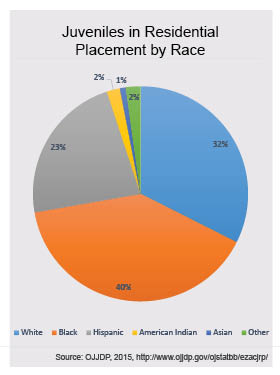Public discourse on the topic of mass incarceration across the nation has begun to focus upon an increasingly vulnerable incarcerated population: juvenile offenders. Within the overall framework and critique of the United States carceral landscape there has been a large amount of interest paid to adult incarcerated populations; however, incarcerated youth have seemingly been absent from the dialogue. Elgin Community College, a suburban Chicago community college, has made initial steps in the advocacy and centering of youth in incarcerated spaces. The school has partnered with the Kane County Juvenile Justice Center to provide its incarcerated youth with two dual credit college courses. The dual credit program, which received funding through a $35,000 Title One grant, focuses on topics like time management, career assessment, and career development that includes aptitude tests. The essence of the program is the encouragement for students to think about their future while also building self-esteem and positive outlooks on life (Morris, 2016). The program is part of a larger initiative of the facility meant to engage the youth in areas such as art, music, and, of course, academics.
The Kane County Juvenile Justice Center admits approximately 1200 residents per year, and its juvenile justice school houses 40 to 45 students. The length of time in the facility for the youth is, on average, 14 days (Morris, 2016). The educational reality of students in the dual credit program, much like that of the overall youth in the facility and the larger landscape of juvenile justice, is unfortunately bleak. The average age of the youth in the Kane County juvenile justice school is fifteen to seventeen, with half of the students experiencing academic struggles such as being three to four grade levels behind their non-incarcerated peers.
While the population of youth engaged by the United States Juvenile Court System has steadily declined from its peak in 1997 of 1.9 million youth, there are still over 1 million juvenile cases annually (Office of Juvenile Justice and Delinquency Prevention, 2015b). In 2013, on average, there were more than 2,900 juvenile delinquency cases per day (Office of Juvenile Justice and Delinquency Prevention, 2015b). As so many have cried out in opposition of the current criminal justice system in favor of reform or complete abolition of the system it is critical to connect the oppression our adult population is facing to our youth who are facing similar issues. One of every four youths who is adjudicated by a juvenile court is detained (Office of Juvenile Justice and Delinquency Prevention, 2015b). In the US on any random day over 61,000 youths are incarcerated in juvenile facilities, correctional facilities, or group homes, absent from their homes, families, and loved ones (Office of Juvenile Justice and Delinquency Prevention, 2015b). Two-thirds of incarcerated youths are detained for nonviolent charges such as property and drug offenses (Office of Juvenile Justice and Delinquency Prevention, 2015a). The racial disparities within the criminal justice system can also be seen in the juvenile justice system. In fact, 68% of youth detained are youth of color, with Black youth making up the largest share of youth in placement (Office of Juvenile Justice and Delinquency Prevention, 2014a). Black youth consist of seventeen percent of the overall youth population; however, they make up thirty percent of those arrested who are detained in the juvenile system (Arya & Augarten, 2008). Black, Latino/a and indigenous youth who are arrested are 62%, 43% and 1.5%, respectively, more likely than white youth to be prosecuted in the adult correctional system (Arya & Augarten, 2008; Arya & Rolnick, 2009; Arya, Villarruel, Villanueva, Augarten, Murguía & Sánchez, 2009).
Despite the overwhelming odds that our children face within the harsh juvenile justice system it is important to highlight the gains that the partnership between the Elgin Community College and the Kane County Juvenile Justice Center has produced. Although there is still much work to be done to ensure both academic and social support for youth that have been placed into a carceral space, the framework is beginning to change.
References
- Arya, N., & Augarten, I. (2008). Critical condition: African-American youth in the justice system. Washington, DC: Campaign for Youth Justice.
- Arya, N., & Rolnick, A. (2009). A tangled web of justice: American Indian and Alaska Native youth in federal, state, and tribal justice systems [Policy Brief 5]. Washington, DC: Campaign for Youth Justice.
- Arya, N., Villarruel, F., Villanueva, C., Augarten, I., Murguía, J., & Sánchez, J. (2009). America's invisible children: Latino youth and the failure of justice. Washington, DC: Campaign for Youth Justice.
- Morris, C. (2016, August 7). Illinois community college works to reform juvenile offenders. Diverse Issues in Higher Education.
- Office of Juvenile Justice and Delinquency Prevention. (2014). Juveniles in residential placement, 2011. Washington, DC: U.S. Department of Justice.
- Office of Juvenile Justice and Delinquency Prevention. (2015a). The census of juveniles in residential placement 1997-2013. Washington, DC: U.S. Department of Justice.
- Office of Juvenile Justice and Delinquency Prevention. (2015b). Juvenile court statistics: 1985-2013. Washington, DC: U.S. Department of Justice.
- Sedlack, A., & McPherson, K. (2010). Conditions of confinement: Findings from the survey of youth in residential placement. Washington, DC: U.S. Department of Justice, Office of Justice Programs, Office of Juvenile Justice and Delinquency Prevention.




